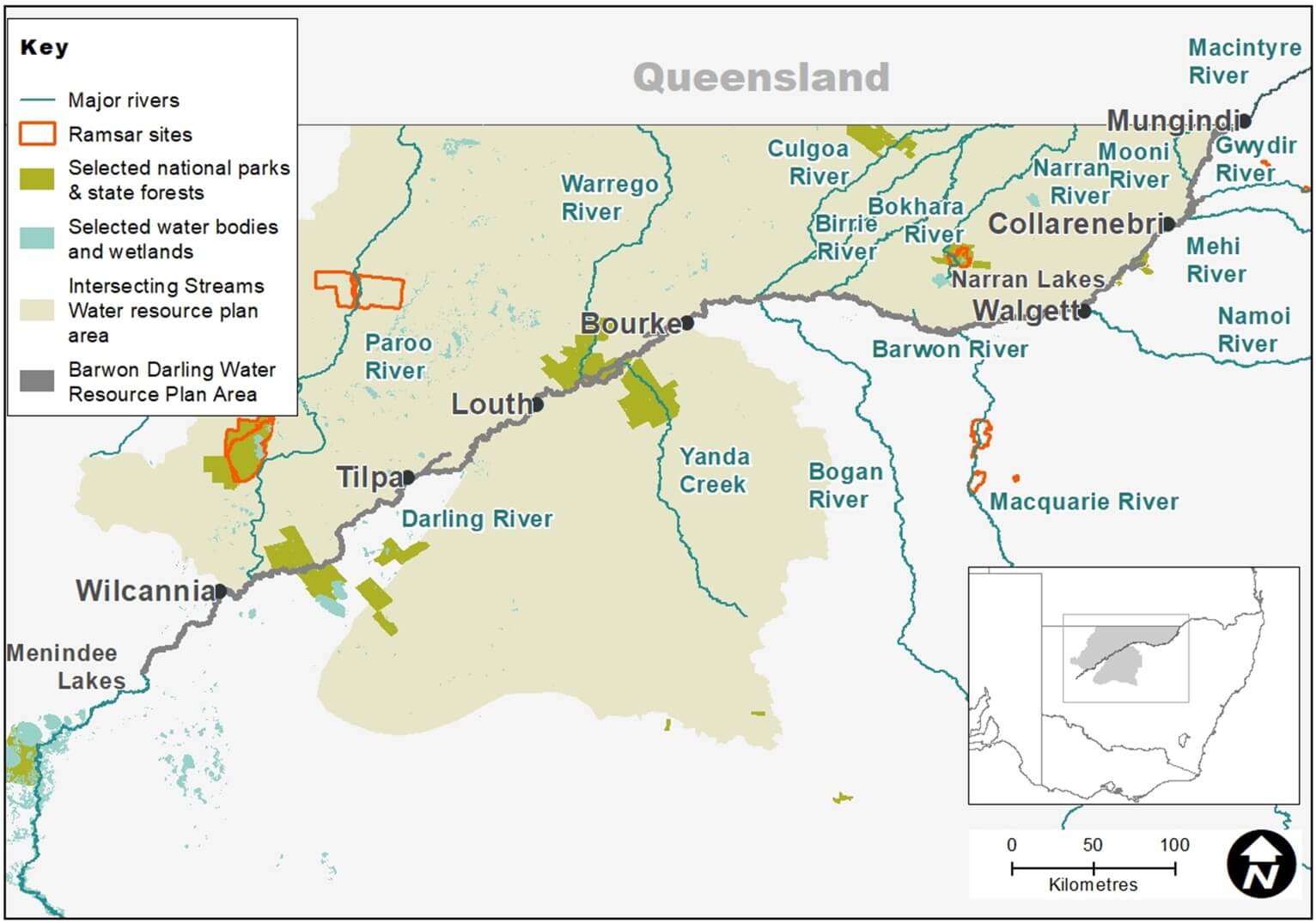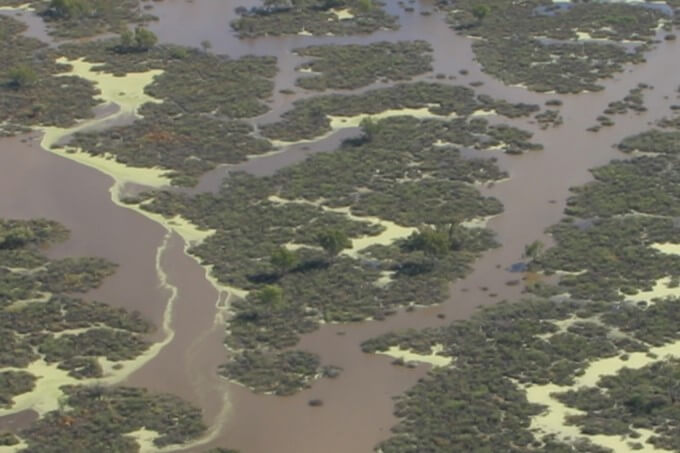The Intersecting Streams arise in Queensland and flow across the border into New South Wales. These streams include the Narran, Bokhara, Culgoa, Warrego and Paroo rivers and key wetland systems including the Ramsar-listed Narran Lakes, Paroo Wetlands and Yantabulla Swamp. The river systems are located on a series of semi-arid floodplains and are fed by rainfall in the central and western areas of Queensland.
Flows in these river systems are intermittent and unregulated, and flow events are typically associated with summer monsoonal weather systems across northern Australia.
The focus of water managers in 2020–21, with an expected dry to moderate resource availability scenario as identified in the Intersecting Streams catchment: Annual environmental watering priorities 2020–21, was to optimise the outcomes of recent flows with a focus on creating opportunities for northern basin recovery.
Key outcomes
The 2020–21 water year saw significant rainfall and flows in parts of the Intersecting Streams. Although the Moonie, Culgoa, Narran, Birrie, Bokhara, and Paroo rivers experienced cease-to-flow conditions for most of the year, they were replenished by flows in March 2021.
Significant rainfall upstream of St George through February and March 2021 resulted in flows in the Culgoa, Birrie, Bokhara and Narran rivers from the Lower Balonne. Some of this water reached the Narran Lakes, which received flows for the second year in a row. The Commonwealth Environmental Water Holder participated in this event by protecting 43 gigalitres using their Queensland licenses.
Flows in the Intersecting Streams system in early 2021 included:
- flows within Queensland that reached Narran Lakes in early April 2021
- flows in the Paroo River that inundated parts of the Paroo Wetlands Ramsar site
- small flows in the Warrego system that extended through Toorale National Park and Toorale State Conservation Area in early 2021
- inflows into the Culgoa, Birrie, Bokhara and Moonie rivers in early 2021, which provided connection to the Barwon River.

Intersecting Streams catchment area map
Watering aims
The watering aims identified in the Intersecting Streams Annual Environmental Watering Priorities for the 2020–21 water year under dry to moderate conditions were met by wetter conditions in early 2021.
Unlike regulated catchments, the management of water for the environment in the Intersecting Streams catchment is largely reliant on improving outcomes from unregulated or natural flows in the rivers.
In 2020–21 the Commonwealth Environmental Water Holder identified priority actions to guide the management of their portfolio of water licenses for this system, subject to river flows.
In the Narran system licensed water entitlements aimed to:
- support replenishment flows to maintain habitat at Narran Lakes
- support flows to maintain and, where possible, improve habitat and support naturally triggered waterbird breeding
- support flows that replenish refuge waterholes for native fish in the Narran system.
In the Warrego system, licensed water entitlements aimed to:
- supplement natural flows that provide connectivity between the Warrego and Barwon–Darling rivers
- balance water needs between the Warrego River floodplain and Darling River, facilitated by the operation of water management structures on Toorale National Park and Toorale State Conservation Area.
Outcomes
Due to extended dry conditions in the Intersecting Streams catchment water managers did not expect connectivity to occur to the Darling River, as described in the Intersecting Streams Annual Environmental Watering Priorities 2020–21 (AEWP). However, rainfall did occur and licenses were activated. Monitoring by the Murray–Darling Basin Authority, Commonwealth Environmental Water Holder, and NSW National Parks and Wildlife Service found that some priority outcomes listed in the AEWP were met in early 2021, including:
- replenishment of waterholes and refuges for native fish throughout the Intersecting Streams
- significant inflows to Narran Lakes
- recovery of some riparian and wetland vegetation.
Between January and June 2021, 330 gigalitres flowed past St George in Queensland and into the Culgoa, Birrie, Bokhara and Narran rivers. This large inflow increased resilience and replenished habitat throughout the river systems.
Case study: Narran Lakes filling event
From March to May 2021, flows totalling 31 gigalitres passed the Narran River gauge at Narran Park and flowed into Narran Lakes. This followed an event totalling 61 gigalitres in March to April the previous year. Prior to the 2020 event no flows had reached Narran Lakes for 7 years.
Commonwealth Environmental Water Holder-held water for the environment, which was protected in the Lower Balonne in Queensland, contributed to the 2021 event in the Narran.
Monitoring completed by the Murray–Darling Basin Authority found that inflows inundated just under 2000 hectares of the Narran Lakes. This included Clear Lake, Back Lake, Long Arm and Lignum Swamp.
Similar to the previous Autumn, the partial inundation of the lakes system was followed by the arrival of thousands of ducks and other waterbirds. High numbers of grey teal and coots were counted along with pink-eared ducks, hardheads, Australasian shovellers and grebes, with 38 different waterbird species observed.
No colonial water bird breeding was recorded at Narran Lakes, but a number of threatened species were recorded by NSW National Parks and Wildlife Service water bird surveys, including brolga, black-necked stork, white-bellied sea eagle and freckled duck.
Another notable observation included white-winged black terns, a very irregular visitor to inland regions. These birds had not been recorded in northern inland New South Wales for a decade.
To have significant events 2 years in a row will help the recovery of the Narran Lakes and will have primed the site for potential colonial water bird breeding events with future in flows.

Aerial view of Narran Lakes